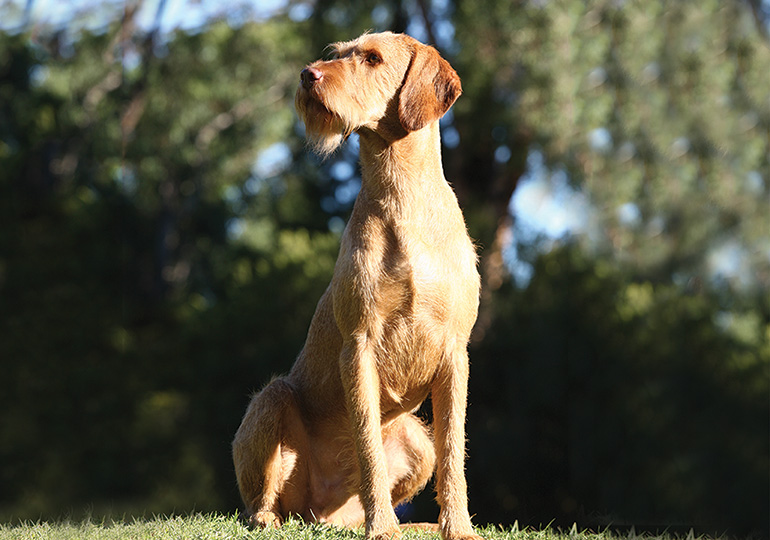Breeds
Hungarian Wirehaired Vizsla

GROUP 3 – GUNDOGS
History
The Hungarian Wirehaired Vizsla is a completely separate breed from its more commonly seen smooth-coated cousin, the Hungarian Vizsla, and was developed in the 1930s. A Hungarian Vizsla was crossed with a German Wirehaired Pointer, with the aim of producing a dog with the same traits as the Hungarian Vizsla, but with a heavier coat and a more substantial frame. This, it was hoped, would make him better suited for working in cold weather and retrieving from icy water and thick undergrowth.
The first Hungarian Wirehaired Vizsla arrived in Australia in 2004. Thanks to the dedication of Fay Harris (Hanafor Kennels) the breed was recognised in Australia in 2007. Since then several additional dogs have been imported, and a number of litters born, but today there are still less than 100 Hungarian Wirehaired Vizslas in Australia, making it a very rare breed.
Hungarian Wirehaired Vizslas are used extensively in their native Hungary, as well as surrounding countries and the UK, in hunting and retrieving activities including falconry. They work equally well on land and in water, and have a reputation of being calm and steady workers. In Australia, examples of the breed have excelled at showing, Obedience, and Retrieving, and they are quickly becoming recognised as the truly versatile workers and wonderful companions that they are.
Appearance
Medium sized, distinguished appearance, with a more robust build and a stronger bone structure than the Hungarian Vizsla. The coat is an attractive russet to golden sand in colour, and should feel wiry, close-lying, coarse, and dense to the touch.
Temperament
High energy, gentle-mannered, loyal, caring, and highly affectionate, Hungarian Wirehaired Vizslas, or ‘Wires’ as they are affectionately known, are natural hunters, pointers, and retrievers. They are eager to learn, love the water, and thrive on interaction with their human family. A combination of intelligence and high energy can lead to them being destructive if they don’t receive enough regular mental and physical stimulation.
Like the Hungarian Vizsla, the Hungarian Wirehaired Vizsla responds best when trained positively, without harsh commands or strong physical correction.
Health
The average lifespan for the Hungarian Wirehaired Vizsla is 10-12 years and for the most part they are a strong, healthy dog. Being a rare breed with a limited gene pool, however, can lead to instances of hereditary diseases if a responsible health screening and breeding program is not followed.
Some of these diseases could include Hip Dysplasia, eye conditions such as ectropion and entropion, hypothyroidism, and epilepsy. It is recommended that prospective owners talk to breeders about their health-screening regime and breeding approach.
Suitability
‘Wires’ are eager to please, so do well at Obedience, Agility, Tracking and Retrieving. They are versatile and adapt easily to new situations, but definitely do best when part of a family with an active lifestyle.
Article by: Louise Bennett and Anne Salisbury
Image: Ffire Photography
In Conclusion
Now you know a little about the Hungarian Wirehaired Vizsla, you may think that this is the dog for you. Before you make a decision, please make contact with the breed club or your State controlling body for purebred dogs. They will be able to give you information about available puppies and also suggest dog shows where you can see the breed and speak to breeders. In this way you will gain a better perspective of the Hungarian Wirehaired Vizsla, and its needs and whether this breed would suit your lifestyle.
Breeders
Sorry, there are currently no breeders advertising for this breed. If you are a registered Dogs SA breeder and wish to advertise here please create an advertisement here.

